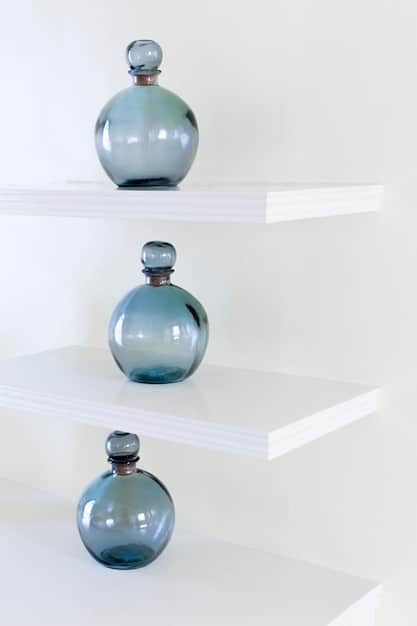The Ultimate Guide to Men’s Cologne: Choosing and Applying Scents

The Ultimate Guide to Men’s Cologne provides comprehensive insights into selecting the perfect fragrance, understanding scent profiles, and mastering application techniques to enhance your personal style and leave a lasting impression.
Navigating the world of men’s cologne can be a daunting task. With countless brands, scent profiles, and application tips to consider, it’s easy to feel overwhelmed. This ultimate guide to men’s cologne: how to choose and apply, will give you all the knowledge and tools you need to select and wear cologne with confidence.
Understanding Cologne: More Than Just a Scent
Cologne is more than just a pleasant smell; it’s an extension of your personality, a subtle statement of intent, and a key component of your overall grooming routine. Understanding the nuances of fragrance can elevate your presence and leave a memorable impression.
What is Cologne, Exactly?
Cologne is a type of fragrance, but what distinguishes it from other fragrance categories? It essentially boils down to concentration. While terms like parfum, eau de parfum, and eau de toilette are often used, cologne typically refers to a fragrance with a lower concentration of aromatic compounds.
The Fragrance Pyramid: Notes Explained
Fragrances are built around a structure known as the fragrance pyramid, consisting of top notes, middle notes, and base notes. Each layer plays a crucial role in the overall olfactory experience.
- Top Notes: These are the initial scents you perceive immediately after application. They are typically light, fresh, and volatile, often including citrus, herbs, or aquatic accords. Top notes create the first impression but fade relatively quickly.
- Middle Notes: Also known as heart notes, these emerge as the top notes dissipate. They form the core of the fragrance and provide body and complexity. Common middle notes include floral, spice, and fruity elements.
- Base Notes: These are the foundation of the fragrance, providing depth and longevity. Base notes linger on the skin for hours and often consist of woody, musky, or amber accords. They are responsible for the dry-down and the overall staying power of the scent.

Understanding the fragrance pyramid allows you to appreciate the evolution of a cologne over time and to make informed choices based on your preferences. Each note plays a role in the complexity and allure of the fragrance.
Decoding Scent Families: Finding Your Perfect Match
Fragrances are typically categorized into scent families based on their dominant characteristics. Familiarizing yourself with these families can help you navigate the vast world of cologne and identify scents that align with your personal style and preferences.
Common Scent Families
- Woody: Characterized by warm, earthy notes such as cedarwood, sandalwood, vetiver, and patchouli. Woody fragrances are often associated with sophistication, masculinity, and timeless appeal.
- Citrus: Dominated by bright, zesty notes of lemon, grapefruit, orange, and lime. Citrus fragrances are refreshing, invigorating, and ideal for daytime wear or warmer climates.
- Oriental: Encompassing rich, exotic notes such as amber, vanilla, spices, and resins. Oriental fragrances are opulent, sensual, and often worn for evening occasions.
- Aquatic: Evoking the essence of the ocean with marine, salty, and seaweed notes. Aquatic fragrances are clean, crisp, and perfect for casual wear or sports activities.
- Aromatic: Featuring herbaceous, green notes like lavender, rosemary, sage, and thyme. Aromatic fragrances are versatile, invigorating, and suitable for both daytime and evening wear.
Recognizing these scent families will give you a framework for selecting the right cologne. Experimenting with different combinations is essential to discover your unique preferences.
Exploring multiple scent families allows you to diversify your cologne collection and express different facets of your personality. By understanding the characteristics of each category, you can navigate the world of fragrances with confidence and find scents that resonate with you personally.
Choosing the Right Cologne for the Occasion
The occasion should greatly influence your cologne choice. A powerful, intense fragrance might be perfect for a night out, but it could be overpowering in a professional setting. Knowing when and where to wear a cologne is just as important as choosing the right scent.
Workplace Scents: Professional and Subtle
For the office, opt for lighter, more subtle fragrances that won’t overpower or offend your colleagues. Consider clean, fresh scents that project professionalism and approachability. Think about aquatic, aromatic, or light woody fragrances.
Evening Events: Bold and Memorable
When heading out for an evening event, you can afford to be a bit bolder with your cologne choices. Richer, more complex fragrances with oriental or woody notes can make a memorable impression. However, always apply with restraint to avoid being overbearing.
Casual Outings: Relaxed and Inviting
For casual outings or daytime activities, choose a cologne that is relaxed and inviting. Citrus or aquatic fragrances are excellent choices, as they evoke a sense of freshness and vitality. They are versatile and well-suited for various social settings.
- Seasonality Matters: Consider how the seasons affect your cologne choices. Lighter, fresher scents are ideal for spring and summer, while warmer, richer fragrances are better suited for fall and winter.
- Personal Chemistry: Remember that cologne reacts differently with each person’s body chemistry. What smells amazing on one person might not smell the same on you. Always sample fragrances on your skin before making a purchase.
- Confidence is Key: Ultimately, the best cologne is the one that makes you feel confident and comfortable. Choose scents that resonate with your personality and style, and wear them with assurance.
Mastering the Art of Cologne Application
Knowing how to apply cologne is just as important as selecting the right scent. Proper application can enhance the fragrance’s longevity and projection, ensuring you make a positive impression without overwhelming those around you.
Strategic Application Points
Apply cologne to pulse points where the body generates heat, as this helps to diffuse the fragrance. Common pulse points include:
- Wrists: A classic application point, but avoid rubbing your wrists together after applying, as this can break down the fragrance molecules and diminish its longevity.
- Neck: Applying cologne to the sides of your neck allows the scent to waft upwards, creating a subtle but noticeable aura.
- Behind the ears: Another warm area that helps to diffuse the fragrance.
- Chest: Spritzing cologne on your chest allows the scent to subtly emanate from beneath your clothing.
Applying cologne to these areas will help to diffuse the fragrance, allowing it to develop and reveal its full character over time. Start with a modest amount, as you can always reapply later if needed.
Application Techniques: Spray vs. Dab
The method of application can influence the projection and intensity of the fragrance:
- Spraying: Hold the cologne bottle a few inches away from your skin and spray a light mist. This method is ideal for achieving a more even distribution and a lighter, more subtle scent.
- Dabbing: If your cologne comes with a dabber or you are using a sample vial, gently dab the fragrance onto your pulse points. Be mindful of the amount you apply, as dabbing can concentrate the fragrance in one area.
Experiment with different techniques to find what works best for you and the specific cologne you are using. Start with a small amount and adjust as needed to achieve the desired level of intensity.
Longevity and Storage Tips for Your Cologne
The longevity and quality of your cologne can be significantly affected by how you store it and what you do to maintain its integrity. Proper storage prevents degradation, and employing techniques enhance the longevity of the scent on your skin.
Prolonging Scent on Your Skin
To maximize the staying power of your cologne, consider the following tips:
- Moisturize: Applying cologne to moisturized skin helps to lock in the fragrance and prevent it from evaporating too quickly.
- Layering: Using complementary scented products like shower gel or body lotion can create a base for the fragrance and enhance its longevity.
- Avoid rubbing: As mentioned earlier, avoid rubbing your wrists together after applying cologne, as this can break down the fragrance molecules and diminish its staying power.
By following these tips, you can ensure that your cologne lasts longer and provides a consistent fragrance experience throughout the day. Remember that fragrance is a personal experience, so experiment with different techniques to find what works best for you.
Proper Storage for Fragrance Integrity
Store your cologne properly to maintain its integrity. Heat, light, and humidity can degrade the fragrance over time; consider these practices:

- Keep away from light: Store your cologne in a dark, cool place away from direct sunlight.
- Maintain moderate temperature: Avoid storing cologne in areas with extreme temperatures, such as bathrooms or near heaters.
- Keep the cap on: Always replace the cap securely after each use to prevent evaporation and oxidation.
Building Your Cologne Wardrobe: A Scent for Every Occasion
Just as you curate your clothing wardrobe to suit different occasions and seasons, building a cologne wardrobe allows you to express your personality and style through fragrance. Having a variety of scents at your disposal ensures that you are prepared for any situation.
Curating a Diverse Collection
Your cologne collection should reflect your lifestyle and preferences. Consider including:
- Signature Scent: A go-to fragrance that embodies your personal style and can be worn daily.
- Seasonal Scents: Lighter, fresher scents for spring and summer, and warmer, richer scents for fall and winter.
- Special Occasion Scents: More opulent, memorable fragrances for evening events or formal occasions.
Sample and Experiment
The best approach to building your cologne wardrobe is to sample and experiment with different scents. Visit fragrance counters, request samples online, or purchase discovery sets that allow you to test a variety of fragrances before committing to a full bottle.
| Key Point | Brief Description |
|---|---|
| 👃 Scent Families | Understanding scent families helps you choose fragrances that match your style. |
| 📅 Occasion | Select colognes based on the event, from work to evening outings. |
| 📍 Application | Apply to pulse points for optimal diffusion without overdoing it. |
| 🌡️ Storage | Store in a cool, dark place to maintain fragrance integrity. |
FAQ
The difference lies in the concentration of fragrance oils. Cologne has the lowest (2-4%), eau de toilette has 5-15%, and parfum has the highest (15-20%), affecting their longevity and intensity.
Store cologne in a cool, dark place, away from direct sunlight and extreme temperatures, to prevent degradation and maintain its original scent profile over time.
Yes, you can, but consider choosing a lighter, more subtle fragrance for everyday wear, especially in professional environments, to avoid overwhelming those around you.
If you can smell your cologne strongly several hours after applying, or if others comment on it being overpowering, you’re likely applying too much. Less is often more with fragrance.
Common pulse points include wrists, neck, behind the ears, and chest. Applying to these warm areas helps to diffuse the fragrance throughout the day. Avoid rubbing after applying.
Conclusion
Choosing and applying cologne is a personal and nuanced process, blending science with individual expression. By understanding fragrance families, application techniques, and occasion-specific choices, you can cultivate a signature scent that enhances your personal brand and leaves a lasting impression. Experiment, explore, and enjoy the art of fragrance.





